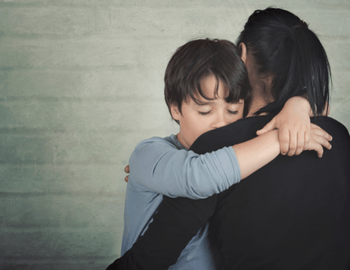Infants and Toddlers
Strangers, loud noises, and especially separation from a key parental or caregiver figure. Tamariki in this age range usually cry when they get anxious.
Pre-schoolers
Insects, animals, darkness, separation from parents or caregivers. Preschoolers often show anxiety through shyness, reluctantance to engage in social situations, and by being extremely quiet or tearful. Anxiety may also be expressed as sleep disturbances and complaints of stomach aches, headaches and non-specific pain.
School-age tamariki:
While infants and young tamariki don’t generally worry, tamariki over 6 or 7 have the cognitive maturity to anticipate a future where bad things could happen.
Older children and teenagers
The focus of fears becomes less concrete in this age group. For example, they may think a lot about family relationships, war, what their friends think of them or their self-image.
Discuss
Encourage your child to talk about their fears. But remember, you can’t demand that the child tell you what’s on their mind. Like adults, tamariki only share information when they feel safe, supported and not judged. With tamariki, it helps to talk to them while doing another other activity, e.g., playing with Lego, taking a walk, cleaning or baking.
Validate
Be sure to validate their experiences. Even if the fears sound silly to you, they are very real to your child. Let your child know that you understand that they are frightened by repeating what they said back to them in your own words. E.g., “It sounds like you feel very scared when Mum drops you off at school because you worry she won’t come back to get you.”
Normalise
It’s helpful for tamariki to know that everyone gets scared at times, even parents. Talk to them about how you face your fears.
Provide coping strategies
When talking about your child’s fears include some coping strategies in the discussion. A good one to start with is breathing and relaxation exercises. Tell your child to take slow deep breaths as if their tummy is a balloon and they are filling it up with air. Or tell them to “go floppy like a puppet with the strings cut so all your muscles are loose and relaxed”.
Help them face their fears
Encourage your child to face their fears gradually. They may need a lot of support initially, but aim to reduce this support slowly.
For example, a child who fears dogs may be exposed at first to pictures and videos about dogs, followed by small dogs behind a fence, on a firm leash and so on. Make sure your child can stay calm at each step before moving on to the next.
Praise positive efforts
Praise the child for facing their fears. For example, if your child is socially anxious, praise them for saying hello to someone in the playground. Experiencing success makes it more likely that your child will be able to muster the courage to speak another child the next day.
Just do it
Sometimes, tamariki simply have to do the things they are afraid of such as seeing a doctor or starting a new school.
At these times, don’t allow your child to avoid the situation. Avoidance can worsen their fear and stops them from learning the truth of their feared situation. For example, a child who has never been to the dentist would not learn that visiting the dentist is actually OK. The key here is to prepare your tamariki for what to expect and then focus on what they did well.
When should you seek professional help?
If you’ve tried these strategies and your child is still experiencing fears and anxieties, it may be time to consult a professional.
We have teams of expert
psychologists
and
art therapists who can help your child face their fears and learn to control their anxieties.
Get in touch to find out more about how we can help.



